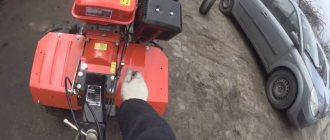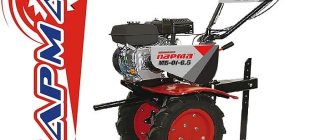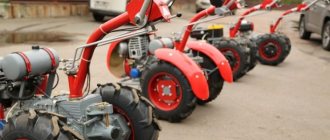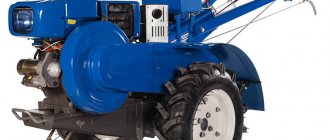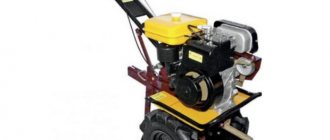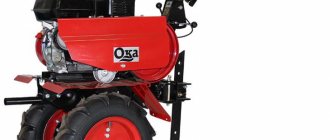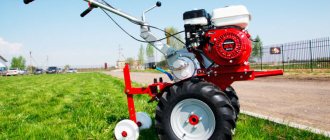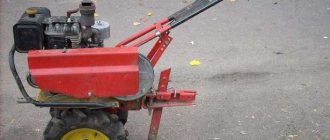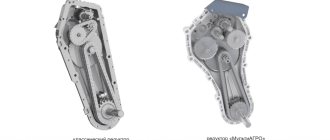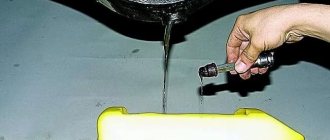If you purchased a walk-behind tractor to work on the site, you will have to constantly check the technical condition of the equipment. Thus, you can extend the life of your iron assistant. The question immediately arises of what kind of oil to use in the walk-behind tractor engine: what kind to pour, how to check the level or replace it.
Walk-behind tractor
Description
Motoblocks "Cascade" have proven themselves as reliable farmer's assistants.
These are productive, durable machines capable of working with a full range of mounted implements, performing the functions of a cultivator, plowing machine, mower, snow blower and many others. In order for the walk-behind tractor to work without failures for many years, you must follow the instructions during its operation.
Timely maintenance of the walk-behind tractor is also important. For the Cascade, the maintenance schedule is the same as for any other household walk-behind tractor:
- scheduled maintenance: once a season, at the end of seasonal work and before it begins (at the beginning and end of spring, at the beginning and end of summer, etc.);
- regular mini-inspection - every day upon completion of work and turning off the walk-behind tractor, as well as an external inspection in order to identify damage, chipped paint, etc.;
- winter storage - is allocated to a separate maintenance category, since it involves draining all fuels and lubricants and storing the walk-behind tractor in a room with a positive temperature; upon completion of the winter “preservation” the unit is refilled with fuel and lubricants;
- annual engine prevention (detecting faults, eliminating them, maximizing the service life of the motor and other key components of the unit).
Next, we will look at the basic rules and requirements for fuels and lubricants, the process of starting and running in the Cascade walk-behind tractor, as well as the most common malfunctions of these devices.
Instructions and recommendations for use
The reliability and long service life of the walk-behind tractor depend on the operating conditions, maintenance, care of the unit, and proper running-in after its purchase. To do this, you must follow all recommendations for operating the equipment.
They boil down to the following:
- Assemble the walk-behind tractor. The assembly diagram can be found in the instructions that came with the unit upon purchase.
- Fill the tank with clean gasoline.
- Check the oil level in the engine crankcase.
- Inspect the wheel mountings.
- Check engine valve clearances. The valves are adjusted using feeler gauges of 0.10-0.25 mm.
- Run-in as follows:
- do not start work with a cold engine;
- the engine must first idle;
- do not load the engine during operation;
- running-in should last at least 30 hours;
- work only in first gear;
- After break-in, change the engine oil and check the bolt connections.
- Adjust the tension of the forward and reverse belts of the V-belt drive by changing the length of the chains.
- Check the operation of the controls.
- Lubricate the starter regularly.
- Fill the gearbox with oil in a timely manner.
- Do not allow it to get into the filters.
Many farmers are wondering what kind of oil should be poured into the walk-behind tractor. In particular, they are interested in the MB 6841 walk-behind tractor with M-12GI or M-10GI filling. These are old brands of oils and are not so easy to find.
The following fuels and lubricants are suitable for Cascade walk-behind tractors:
- in the fuel tank - motor gasoline Normal-80, GOST R 51105-97;
- in the engine crankcase - motor oil M-5z/10G1, M-6z/10V, M-6z/12G1, GOST 10541-78;
- for the gearbox - transmission oil in accordance with GOST 23652-79 or aviation oil MS-20, GOST 21743-76.
Synthetic and mineral materials cannot be mixed.
The operating instructions also contain safety information, which is aimed at protecting the operator, as well as protecting the equipment from damage during operation. It is strictly forbidden to warm up the engine using an open flame, such as a torch.
To set the walk-behind tractor in motion, you must select a gear using the handle and using the markings on the body, and then press the forward or reverse lever. It is prohibited to change gears with the forward or reverse lever cocked into the working position.
How to choose oil for a walk-behind tractor?
Its factory manual for regular use can provide accurate information about a suitable branded lubricant for the built-in motor of a walk-behind tractor. As a rule, the manufacturer indicates the type of liquid, its base and manufacturer’s brand. The company manual also contains instructions from the equipment manufacturer, telling you how much lubricant should be poured into the factory engine and exactly how to do it correctly.
However, not everyone has the original manual for the walk-behind tractor they are using. In this case, the operator needs to remember that, depending on the original purpose, 2-stroke and 4-stroke factory oil are available for sale. Most often, utility walk-behind tractors are equipped with factory-made 4-stroke engines, but immediately before purchasing lubricant, it is still better for the user to first study the markings stamped on the engine wall.
Depending on the type of lubricant base, the market differs between semi-synthetic and synthetic branded oils for walk-behind tractors. In some agricultural equipment stores you can still find mineral-based liquids, but they are increasingly being replaced by synthetic lubricants. There is an opinion among experienced users that synthetic oils are universal and can always be used, regardless of weather conditions. However, this is not quite true. The point is that the existing composition of each type of technical fluid contains various natural components and additives, which, with a sharp drop in temperature, instantly lose their original properties and freeze. That is why factory motor oils are usually divided according to the season of operation - into summer and less viscous winter ones.
Another important factor when choosing technical fluid is its thickness. The oil must envelop the moving parts of the internal combustion engine of the walk-behind tractor, and for this it must be evenly colored and sufficiently viscous. At the same time, you should not choose a liquid that is too thick, otherwise it will not be able to seep into the smallest grooves of the factory engine.
Repair instructions for walk-behind tractor "cascade"
Malfunctions in the Cascade walk-behind tractor can appear in different parts of it. They can be divided into two types: breakdowns in the engine of the unit itself and in its other constituent elements. Before you begin repairing engines or carburetors, read the instructions carefully. In it you can find answers to a variety of questions.
Motor.
You may even need to rebuild the engine, that is, overhaul it. If your car has been serving you for many years, then perhaps the engine is simply worn out and needs to be thoroughly repaired and cleaned. Frequent faults:
- the engine does not start. There may be too much gasoline, which can be determined by the spark plug being wet. You need to dry the cylinder, remove the spark plug and accelerate the engine using a manual starter. If you have an electric starter, the battery may be discharged, which will also cause the unit to not start;
- insufficient engine power. Check the carburetor filter. If you use low quality gasoline, it may cause your car to perform poorly. A clogged spark plug or a violation of the gap between the electrodes will lead to a malfunction in the ignition system. Clean the muffler as well.
Carburetor.
If you notice that your walk-behind tractor is somehow not working properly or there are some changes in its operation, first check the carburetor and study the instructions.
Fuel may not reach the carburetor. To check this, you need to unscrew the spark plug. If it is completely dry, then gasoline simply does not reach here. You need to clean the carburetor filter or jet.
To conduct a complete examination of the carburetor, it must be removed and disassembled, and the fuel must be poured out. Then blowing is done through the fitting. Nothing should obstruct the flow of air, and keep the unit as it is during operation. But if you turn it 180 degrees, the air should no longer pass through.
To adjust the flow of fuel, you need to bend or bend the tongue on the float in the chamber. After this, you can blow out the jet. All parts must be cleaned with fuel and left to dry without wiping them.
The last step is adjustment, but before that you need to warm up the engine. You need to set the idle speed to the lowest setting. You need to tighten and then gradually unscrew the gas screw, monitoring the operation of the machine.
Breakdowns in other components.
So, for example, if your unit has become too noisy, then you may need to repair the gearbox of the Cascade walk-behind tractor. First, try adding or completely replacing the oil in it. If this does not help, you need to contact a technician who will replace the faulty part.
Which engine is better to put on a cascade walk-behind tractor?
It is necessary to take into account the fact that the domestically produced engines that were produced for this walk-behind tractor no longer exist. So you will need to choose among the imported assortment. But it’s almost impossible to find a part that meets all the parameters.
The following engines are most often installed on the Cascade:
- DM 68 is a good quality engine, which is recommended as one of the best options for installation on such equipment. Its main advantage is a reinforced transmission and high-quality assembly. Technical characteristics: power - 6 hp;
- fuel tank: 3.3 l;
- processing depth – 26 cm;
- processing width – 45/60/95 cm;
- number of gears: 2 forward, 2 reverse.
- B&S I/C is a modern engine model that is very popular among walk-behind tractor owners. This is due to its main features:
- reinforced transmission;
- increased power of 6.5 liters. With.;
- fuel tank with a volume of 3.6 liters;
- minimum noise level;
- efficient operation even at low temperatures.
- Vanguard OHV is a powerful engine that will help you get the job done quickly and efficiently. This high level of performance is achieved thanks to its power of 7.5 horsepower and fuel tank capacity of 4.5 liters.
When purchasing an engine, pay attention to its build quality. It must meet all modern requirements, this will ensure the unit a long service life and operational efficiency.
Read also: Motoblock Aurora Gardener 750
How to choose gear oil for a walk-behind tractor?
When choosing a lubricant, consider the following factors:
- Lubricity is the main parameter of any, including branded, transmission oil for the walk-behind tractor used. It is necessary to protect the rubbing parts of the gearbox - gears and bearings from the formation of burrs, grooves and staining. As the viscosity of the oil increases, its ability to lubricate increases. Another way to improve this parameter is to add various additives to the liquid. The viscosity of the lubricant used directly affects its ability to coat the gearbox parts with a durable oily film. At the same time, a viscous liquid quickly thickens at low temperatures, losing its ability to protect the elements of the mechanism;
- resistance to thermal oxidation - this property of the oil is responsible for its stable operation at very high temperatures. To do this, manufacturers add special antioxidant additives to the liquid;
- anti-corrosion protection – the compositions of many branded lubricants for walk-behind tractors contain corrosion inhibitors. Their main function is to prevent the appearance of rust on the moving parts of the gearbox;
- resistance to foam formation - for this purpose, defoamers are added to oils, which prevent foaming of liquids during their operation.
In any weather and operating conditions, ZIC 10W-40 and Gazpromneft Super T-3 85W-90 fluids have proven themselves to be quite good. These oils are distinguished by a wide range of operating temperatures, as well as a high level of viscosity and the content of useful additives.
Carburetor K-60
The carburetor should be adjusted strictly according to the manufacturer's instructions for a specific model. Otherwise, you can simply break the equipment.
The K-60 carburetor is used in the M-3 model. He will require that the throttle valve be installed so that the gap between its base and the air duct is 2-2.5 mm wide. It can be seen through the pipe of such a unit as the Cascade walk-behind tractor. Adjusting the carburetor will require tightening the adjustment screw and turning it out 0.5-1 turn.
Then the engine 5 min. warm up and, turning off the adjusting screw, wait for the engine speed to decrease. This is the optimal position. To determine it at minimum speed, the rotation speed is reduced and, by smoothly turning the screw, its optimal position is found.
Knowing the principle of operation and the main characteristics of the unit, you can effectively and safely use equipment such as the Cascade walk-behind tractor. Carburetor adjustments should be made as necessary in accordance with the manufacturer's instructions.
Adjusting the operation of this component of the equipment will ensure stability of the engine speed after prolonged loads or inactivity. The presented walk-behind tractor is guaranteed to last a long time, and the actions performed with its help will not require much physical strength. Proper care and adjustment of the unit will allow you to avoid emergency situations during the processing of land plots.
Brief overview of modifications. how to decipher factory indexes
Over the years of production, Reductor-PM OJSC has brought to the market so many modifications of the Cascade walk-behind tractor that, at first glance, it seems that there are too many of them and one can get confused in them. However, it is not. In fact, it's simple. You just need to “read” the alphabetic and digital designations in the factory indices of these walk-behind tractors.
MB6 is a model with a domestic engine (“DM66” or “DM68”). MB61 is a model with a foreign-made engine (“Briggs&Stratton” or “Honda”).
01 – steering rod. 02 – rotating steering column, which allows you to adjust the position of the steering wheel in the vertical and horizontal planes.
In the 04 series gearbox, the gearbox output shaft is mounted on needle bearings. In gearboxes of the 05, 06, 07 series, the gearbox output shaft is mounted on ball bearings.
Also, the gearboxes of the 05 and 06 series provide a reduced speed in first gear, which provides a number of advantages, for example, when working with a mower and snow blower, it allows you to mow grass and remove snow more efficiently.
The gearboxes of the 06, 07 series also use a mechanism for disconnecting the output shafts, which makes it easier to control the walk-behind tractor when turning, increases its maneuverability when used as a vehicle and when cultivating the soil.
Basic options on the basis of which all modifications of the Cascade walk-behind tractors are made:
Each modification of the Cascade walk-behind tractor provides a standard tillage depth of up to 26 centimeters. The processing width while the walk-behind tractor is moving is 45, 60 or 95 centimeters.
Design and principle of operation of the device
The design of the Cascade walk-behind tractor differs from similar mechanisms in the ability to change the inter-wheel space. It is also possible to change the height of the control handles, which makes the unit more convenient when working with various attachments. “Cascade” weighs 107 kg, has a strong frame on which all components of the unit are installed. The wheels are pneumatic, which makes the ride softer.
The "Cascade" walk-behind tractor has pneumatic wheels
Oil and fuel
Every owner should know what oil and fuel his Cascade walk-behind tractor works with.
Regardless of what kind of engine you have (Russian-made or Chinese Lifan), you must use only high-quality clean fuel AI-92 or AI-95. Do not use old or dirty gasoline. It can clog the fuel system.
Fuel is taken from the gas tank not from the bottom of the tank, but a little higher. This prevents dirt and dust from entering further into the carburetor, but it simply settles to the bottom.
Changing the oil in the engine of the Cascade walk-behind tractor:
According to the instructions for use, it is recommended to use Soviet oils in accordance with GOST. However, the time of the USSR has already passed, and now you can find higher quality imported motor oils with improved characteristics. In summer, you can use 15W-40 series, and in winter, semi-synthetic 10W-40.
The oil should be changed every 20 hours of operation of the Cascade walk-behind tractor.
The situation is similar with the transmission. The manufacturing plant recommends using Soviet TAP-15v or TAD-17i. However, 75W-90 or 80W-90 can be used instead.
To change the transmission oil, tilt the walk-behind tractor back and pull out the plug. Before doing this, place the container for drainage. Excavation causes great harm to the soil, so you should not pour it there.
Control levers are lubricated with Litol or Solidol.
Oil for diesel walk-behind tractor
The engines into which diesel is fueled differ from gasoline power units. Accordingly, to maintain their smooth operation, you need to choose a completely different type of lubricant.
The main factor when purchasing lubricant for a diesel factory engine is its viscosity, marked with the SAE designation followed by a set of letters and numbers.
The latter will tell the buyer in what conditions it is best to use the selected lubricant:
- SAE 0W, SAE 5W or SAE 20W – designed for use in regions with harsh, long winters;
- SAE 20, as well as SAE 40, SAE 60 - marking without letters means that this is a highly viscous liquid that has proven itself well in hot summer weather;
- SAE 5W-30, SAE 10W-40 are all-season oils that work effectively both in winter and hot summer.
The classification presented by the American Petroleum Institute divides motor oils for household and professional walk-behind tractors according to their operating groups. Accordingly, the following types of lubricants are found on the market:
- API CJ-4 - used in proprietary high-quality, very powerful motors, which are designed specifically for operation under high loads. Experienced gardeners recommend using factory-made oils of this particular type for everyday lubrication of engines produced by the Briggs & Stratton and Honda brands;
- API CC - used for power units without built-in superchargers and with turbocharging. These oils provide continuous protection of built-in engine parts from corrosion, gum deposits and increased wear.
When choosing oils of these types, you need to pay special attention to their manufacturers. It is best for users to trust well-known companies, which include the brands Elf, Liqui Moly, Motul, Shell and others.
The lineup
The model range of the Cascade walk-behind tractor consists of various modifications, differing in the type of engine and, accordingly, the technical characteristics of the device. For example, the “Cascade MB 1” walk-behind tractor has 8 horsepower, only one speed in reverse, and is capable of plowing a strip of land up to 1050 mm to a depth of 150-300 mm.
In the last few years the following modifications have been developed:
- MB6-06 – the “Cascade MB 6” walk-behind tractor has a powerful gearbox with an additional set of speeds and wheel unlocking, but has a standard steering column.
- MB6-08 – has an increased speed of up to 10 km/h. The model is the most popular in its niche.
- MB61-12 - the speed of this model is even higher than its predecessor - up to 12 km/h, while the model is 11 kg lighter than the standard one. Such monoblocks cost up to 40,000 rubles.
- MB61-21 – this model is equipped with a Robin-Subaru EX-21 engine with a cylinder capacity of 211 cm3. Fuel consumption does not exceed the standard - 1.6 and 1.8 l/hour.
- MB61-22 - the model is equipped with a Honda GX-200 engine with technical characteristics standard for these walk-behind tractors.
The model range of the “Cascade” walk-behind tractor consists of various modifications
Owner reviews
Nikolay, Rostov: “I have been using the Cascade walk-behind tractor for 5 years, the reviews are only positive, there are no comments. He plows and carries loads on a hitch. The engine power is quite satisfactory. There are special attachments for cultivation. Despite the fact that the operating instructions for the Cascade walk-behind tractor state that its permissible speed is 10 km/h, I “drive” it up to 15 km/h.”
Alexander, Kaluga: “The price of the Cascade walk-behind tractor is quite reasonable - on average 30,000 rubles if you buy directly from the manufacturer. Although there are models that are more powerful, they are also more expensive – up to 45,000 rubles. But it’s worth it; the cost of purchasing a walk-behind tractor of this series pays off very quickly. I’m glad that the production of walk-behind tractors has been established in our country, because this is a guarantee of quality.”
Peter, Tula: “I bought the Cascade MB6-06-05-02 almost 7 years ago. In the first year, the plastic gas tank broke, which, as it turned out, was installed on this particular model. The disadvantages also include its too much power for digging up potatoes, it just cuts them.”
Engine system malfunctions during startup
If, when checking the spark plugs, they turn out to be wet, i.e. fuel flows normally, but the engine does not start, the problem may be the following:
- Ignition system failure:
- Air leaks through carburetor seals, spark plugs, plug and cylinder heads, as well as carburetor and engine cylinder connections.
If depressurization of connections is detected, it is necessary to tighten the mounting bolts, tighten the spark plugs and check the integrity of the gaskets between the spark plug heads and the cylinders.
- Incomplete closing of the carburetor air damper.
To eliminate this problem, it is necessary to ensure free movement of the damper by monitoring the quality of the drive. If jams are detected, they must be eliminated.
Compression failure and carburetor problems
It happens that the launch is carried out, but the process is significantly difficult. At the same time, the engine of the walk-behind tractor is extremely unstable and cannot develop sufficient power for normal operation.
The reason for this may be loss of compression, which can be identified by:
- carbon deposits on the working surfaces of valves, as well as cylinder block seats;
- intake valve deformation;
- wear of piston rings.
In order to restore compression, you must:
- Check the technical condition of the engine gas distribution mechanism, clean the parts contaminated with carbon deposits, and if there are defects, replace them.
- Check the condition of the piston rings and replace faulty components.
If during engine operation black smoke comes out of the muffler, and excess oil is detected on the electrodes of the spark plugs or they themselves are covered with soot, this means that:
- a supersaturated fuel mixture is supplied to the carburetor;
- the sealing of the carburetor fuel valve is broken;
- the piston oil ring is worn out;
- The air filter is clogged.
Is it possible to fill a walk-behind tractor with motor oil?
The difference between internal combustion engines for walk-behind tractors used on farms and modern cars is:
- specifics of the factory design;
- boost level;
- the material from which motor components are made.
The use of automobile factory engine oil for continuous lubrication of the internal combustion engine parts of a walk-behind tractor gradually leads to accelerated daily wear of the latter’s standard chrome-plated cylinders, its piston group, as well as to mechanical damage to the carburetor, factory filter elements and rubber fuel pipes.
Step-by-step instructions for setting up a carburetor
- Warm up the engine.
- Screw in the maximum and minimum throttle screws until they stop.
- We unscrew the same screws back only 1.5 turns.
- Set the gear lever to the minimum travel position. However, the engine continues to run.
- Normal operation of the engine should be silent and continuous.
This operation should be carried out by Cascade units at each beginning of the season or at its end. Due to the fact that the screws are screwed in all the way, the fuel is enriched. But their slight weakening increases the air in the mixture.
In order to check whether you did everything correctly when adjusting, you just need to pay attention to the spark plugs. After prolonged hard work on the walk-behind tractor, after a short time, neither soot nor traces of fuel should form on the spark plugs.
Carburetor of the Cascade walk-behind tractor: 1 - air pipe; 2 - body; 3 - drowner; 4 — idle jet; 5 — throttle stop screw; 6 — throttle lever; 7 — carburetor mounting flange; 8 — screw for adjusting the composition of the idle fuel mixture;
Is it necessary to add oil to gasoline for a walk-behind tractor?
The answer to this common question can be given based on the type of factory engine of the existing walk-behind tractor. Agricultural units are equipped with 2- or 4-stroke power units. Gasoline for a walk-behind tractor with a factory 2-stroke engine must be diluted with engine oil, being sure to adhere to the proportion specified by the manufacturer.
It is important to remember that 2- and 4-stroke internal combustion engines operate on different principles. Fuel combustion in engines of the first type occurs continuously in 2 strokes. At the same time, the branded oil with which the fuel mixture is prepared contains not only lubricating components, but also additives that improve the quality of the fuel. In 4-stroke factory engines, oil and fuel for the walk-behind tractor are always poured separately, into tanks specially designed for this by the manufacturer.
Rules for operating and maintaining the unit
During the first hours of operation, you need to put a gentle load on the Cascade walk-behind tractor. The owner's manual recommends a 35-hour break-in cycle. During this time, the following conditions must be observed:
- within 5 min. the engine warms up at medium speed;
- work is carried out in first gear and medium speed;
- after 5 hours of operation, the oil must be replaced;
- the next portion of oil is changed after 5-7 hours;
- then the oil is changed after 35 hours;
- All connections are inspected and bolts are tightened.
In the future, for 1-2 months you should not give the maximum load to the unit. It is necessary that all parts get used to each other.
Maintenance should be carried out during operation. It comes down to these points:
- daily removal of dust and oil from surfaces;
- monitoring and pulling fastenings if necessary;
- belt inspection. Replacement in case of delamination;
- checking the fastening of attachments;
- The oil in the gearbox is changed every 50 hours.
When replacing a belt, you need to pay attention to the indices stamped on them. They come in A1180 and A1400.
During the work, the steering wheel is set at the required height, which is kept parallel to the ground. Skew is not allowed. Otherwise, the unit will bury itself in black soil. The depth of soil cultivation is 200 mm, and in difficult areas 100-150. If the ground is rocky, then work is carried out in first gear.
Storage is carried out in a dry room or outdoors under a tarpaulin. In case of preservation, all unpainted parts are coated with K1 lubricant. Storage time - 1 year. If longer storage is necessary, the lubricant is changed.
Attachments
The additional functions of the walk-behind tractor are very diverse and help a person to carry out a variety of work in the field and in the yard throughout the year.
Suspended equipment for walk-behind tractor:
- plow;
- hillers;
- potato planter;
- potato digger;
- mower.
Special equipment includes:
- a milling cutter that allows deeper plowing of dry, steppe soil;
- creeper;
- hitch;
- adapter.
Problems with recoil starter
Sometimes it becomes necessary to replace the starter spring or even the entire device as a whole. The spring itself is placed around the axis of the drum. The task of this spring is to return the drums to their original position. If the mechanism is taken care of and is not pulled too vigorously, the device will work quietly for years. If a breakdown occurs, you must first remove the washer located in the middle of the drum body.
Then remove the cover and carefully inspect all the parts. Attention: it is better to prepare a box in which the parts to be removed will be laid out. There are a lot of them, and they are also small. After the repair, you will need to install everything back, otherwise the starter will stop working altogether. In most cases, it is necessary to replace the spring or cord, but a conclusion about this can only be made by visual inspection.
Although Cascade walk-behind tractors are equipped with strong cords, rupture cannot be ruled out. But if it is relatively easy to change the cord, then when replacing the spring you need to make sure that the connecting hooks are not damaged. When replacing the entire starter, first remove the filter covering the flywheel. This allows access to the internal parts of the device. Having removed the casing, unscrew the screws holding the basket.
The next steps are:
- unscrewing the nut and removing the flywheel (sometimes you have to use a wrench);
- unscrewing the key;
- installing a generator with inserting wires into holes on the motor wall;
- placement of magnets in the middle of the flywheel;
- connecting parts with fastening bolts;
- installation of the crown (if necessary, using a torch);
- returning the unit to the motor, screwing in the key and nut;
- installation of the mechanism basket;
- securing the insulating casing and filter;
- setting the starter;
- connecting wires and terminals to the battery;
- test run to check system functionality.
Motoblock gearbox "cascade"
The gearbox is mechanical, chain. The clutch and manual transmission are the basic components of a transmission and are often housed in a special unit.
Most models have multiple forward and reverse speeds for excellent maneuverability.
The output shaft of the reinforced gearbox is located on bearings with a significant diameter, which are resistant to mechanical damage and the negative influence of various types of vibrations.
Figure 3. Diagram of the “Cascade” gearbox
1— Retaining ring, 2 — Adjusting ring, 3 — Bevel gear, 4 — Adjusting rings, 5 — Bearing, 6 — Intermediate gear shaft, 7 — Upper housing, 8 — Output shaft, 9 — Adjusting rings, 10 — Bearing, 11 — Bevel gear, 12 — Lock ring, 13 — Boot cup, 14 — Boot, 15 — Cuff, 16 — Adjusting rings, 17 — Lower housing, 18 — Adjusting spacer, 19 — Bearing, 21 — Cover, 22 — Gear, 23 - Gear, 24 - Shaft.
Repairing a walk-behind tractor engine with your own hands: common faults, photos and videos
Like any equipment, the walk-behind tractor requires timely maintenance and repair. And it is advisable to entrust their implementation to specialists who have the necessary tools and equipment and know their job well.
However, if you are also familiar with the structure of internal combustion engines and understand the topic of mechanical engineering, then you can do a lot of what may be required to restore the machine’s performance on your own.
Diesel and gasoline engines have different motor resources. For the former, the normal figure is 4000 m/h, but the latter are capable of providing only 1500 m/h. Despite this, diesel models of walk-behind tractors are not in high demand. After all, both when purchased and during operation they are much more expensive.
Therefore, most likely, you are working with a walk-behind tractor equipped with a gasoline (carburetor) engine.
All breakdowns that may occur during the operation of agricultural mini-equipment can be divided into two categories:
- startup problems;
- malfunctions.
- Malfunctions of other components and mechanisms:
- improper clutch operation;
- breakdowns in the gearbox;
- problems with the chassis;
- control and automation malfunctions;
- malfunctions of walk-behind tractor systems (cooling, lubrication, etc.).
In many ways, the success of repairing a suddenly broken machine depends on the correctness of the diagnosis. As for maintenance, it is carried out precisely in order to identify small faults that will later lead to serious ones.
If you do not have the necessary knowledge, premises, tools and materials necessary to service and repair the motor, entrust the work to a specialist!
Varieties
The manufacturer of the domestic brand "Cascade" produces several models of walk-behind tractors on the market, which differ in design.
Types of units.
- Angular - provides connection between the power plant and transmission. Most often used by farmers for farming. The features of this type include the ability to complement, improve, increase productivity, and reduce labor costs.
- Reducing - in this case, the mechanism increases the engine load and also reduces the number of revolutions during operation. According to reviews from owners of the gearbox, it is distinguished by its reliability, versatility, due to the use of durable material in the manufacture of each part, as well as being equipped with a high-quality cooling system. Another advantage of the step-down type is high performance under any load conditions.
- Reverse gearbox is a mechanism with a reverse function, which is mounted on the main shaft. True, it has two disadvantages - low speed, poor performance.
- Gear – designed for large size models. Despite the simple design, the robust, reliable body is quite difficult to maintain.
- Worm - the main parts include a special screw and a toothed worm wheel. Each spare part is made from durable material, which allows us to call this type of gearbox the most reliable. Among the advantages, the manufacturer highlights a reduced angular velocity and a higher type of torque. In operation, the gearbox does not create much noise and operates smoothly.
Table of engine malfunctions of the "cascade" walk-behind tractor
| Malfunction: The Cascade engine stalls during operation and does not start. Reason: no fuel in the tank; the fuel system is clogged; carburetor is out of adjustment; The carburetor is clogged. Repair: gas station; cleaning the fuel filter and hoses; it is necessary to adjust the “Cascade” carburetor; cleaning the carburetor. |
| Fault: black exhaust smoke. Reason: too much oil in the crankcase; the fuel mixture is enriched; The air filter is clogged. Repair: reduce oil level; change the type of fuel; Clean the air filter. |
| Malfunction: poor oil return to the engine. Reason: the ignition timing is incorrect. Repair: the key needs to be replaced with a whole one. |
| Malfunction: the engine does not produce the declared power. Reason: carburetor clogged, carburetor misadjustment; Carbon deposits have accumulated in the fuel combustion chamber. Repair: carburetor cleaning; adjusting the “Cascade” carburetor; you need to remove the cylinder head and clean their cavity from carbon deposits. |
The design of the Cascade walk-behind tractor is simple and classic. Like any similar unit, the “Cascade” consists of a steering rod, a two-wheel chassis, an engine and a power transmission.
Behind the engine there is a transmission, gearbox (gearbox), clutch, main gear, differential, final drive and PTO.
Specifications
The technical characteristics of the Cascade MB-6 walk-behind tractor are as follows:
- Engine type: 1-cylinder, 4-stroke carburetor, air-cooled.
- Power - 6 hp
- Working volume - 317.4 cm³.
- Cylinder diameter - 76 mm.
- The volume of oil in the engine is 0.9 l.
- Crankshaft rotation speed - 2750-3250 1 rpm.
- The type of running system is wheeled in a 2x2 pattern.
- The clutch is a V-belt drive.
- Belt size for walk-behind tractor Cascade:
- forward belt - A-1180 internal IV GOST 1284.1-89;
- reverse belt - A-1400 IV GOST 1284.1-89.
- Gearbox - 2-speed.
- Gearbox seals:
- 941/20 GOST 4060-78 - 7 pcs.;
- 942/30 GOST 4060-78 - 2 pcs.;
- 306K GOST 8338-75 - 2 pcs.;
- 942/15 GOST 4060-78.
- Number of gears:
- forward travel - 2;
- reverse gear - 2.
- The working width with the KMB 1.002.000 cultivator is 930 mm.
- Processing depth - 100-200 mm.
- Operating temperature - -5... 35°C.
- Overall dimensions - 1500x600x1150 mm.
- Machine weight - 103 kg.
The Cascade MB-61 walk-behind tractor has the following design features:
- The MB61-102, 104 units are equipped with Vanguard 7.5 HP type 0035A1 engines from Briggs & Stratton (USA), designed for operation in extreme and difficult conditions. This engine has a displacement of 205 cm³.
- MB61-122, 124 units are equipped with Intek I/C 6.5 HP (Briggs&Stratton) general-purpose motors with high performance, reliability and endurance.
- MB61-142, 144 have Intek Pro 6.5 HP engines with dual Dura-Bore barrels for long lasting performance and a float carburetor for consistent easy starting.
- MB61-152 and 154 with Vanguard 7.5 HP engines type 0127E1.
The features of the Cascade MB61 distinguish it from the agricultural equipment Cascade MB6. Motorized vehicles are efficient, reliable and well-built, but the cost of units with American and Japanese engines is much more expensive. Therefore, walk-behind tractors with domestic engines are more popular among farmers.
Installation of belts
Installing any components on an agricultural device is not labor-intensive work.
Before you independently replace the belts on the Cascade walk-behind tractor, it is best to read the instructions.
In order to save time and nerves, as well as to correctly replace this component, it is best to use our advice and do everything in order.
- Put the gear in neutral and turn off the engine of the device.
- Turn off the engine.
- Remove the protective cover.
- Remove the belts that you plan to replace. Remember that it is recommended to change all elements at the same time. That is why, when installing reverse belts on a Cascade walk-behind tractor, install them for forward driving as well.
- Supply new components. To do this, you need to remove the pulley. Then the part to be replaced is pulled onto the gear pulley. After which the engine pulley is installed.
- Check whether the belts are positioned correctly on the Cascade walk-behind tractor.
- Reinstall the protective cover.
Observe safety precautions when replacing belts on a walk-behind tractor. That's all, the components are installed, and the device is ready for use.
